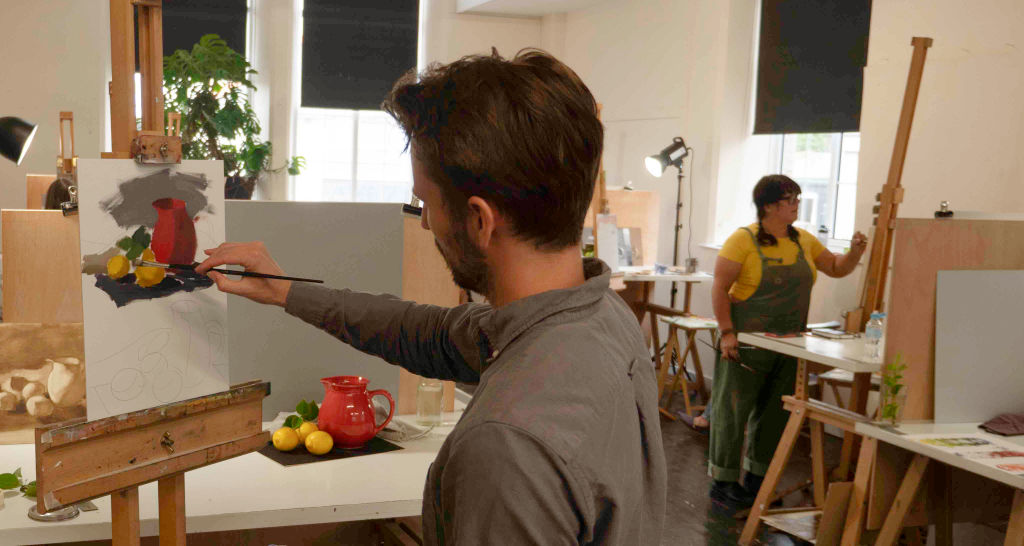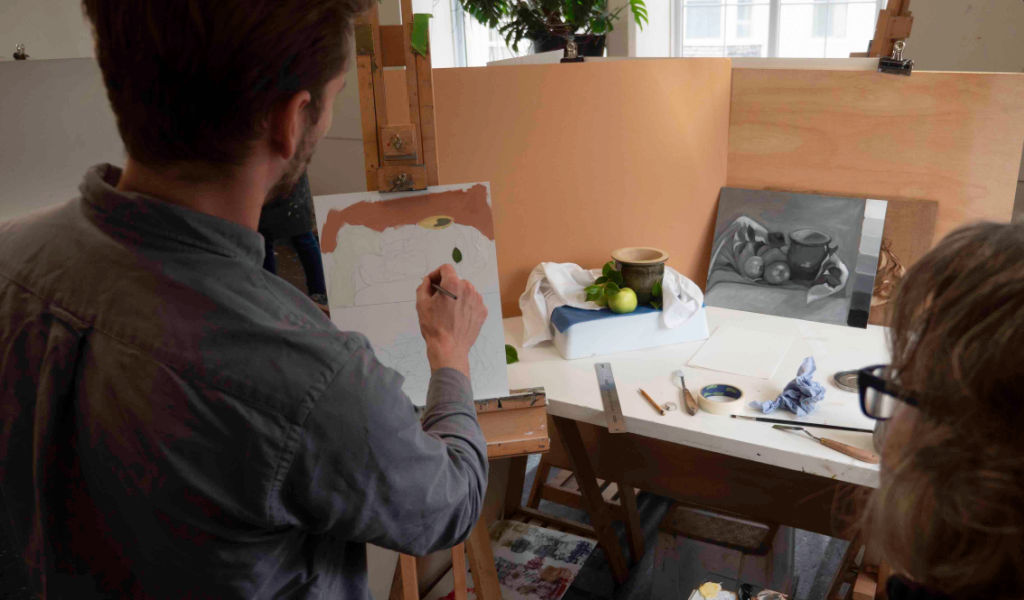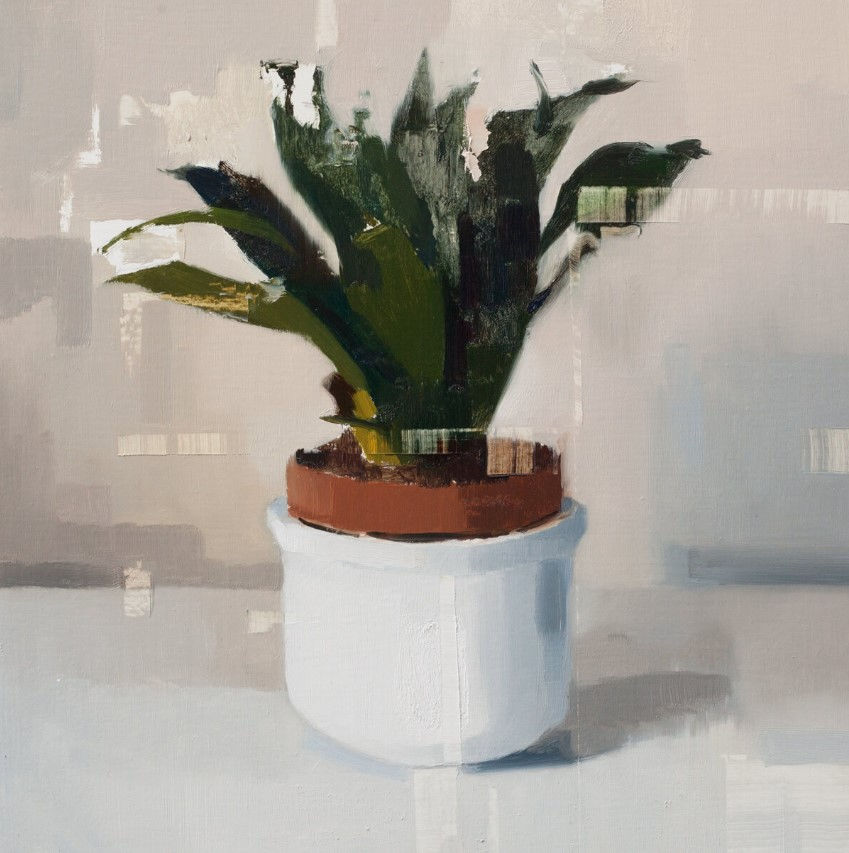
If you feel that you haven’t been taught the classic building blocks of how to paint, then this course may well contain the structured tuition you are searching for. All of us who spent the four days being taught by Jon Doran would vouch for the fact that he has sleekly worked out, step-by-step, what a painting is composed of. He has pared down and simplified what everyone from near beginners like me, with lots of questions and self-doubt, through to more experienced established artists need to understand in order to achieve good results. By teaching one to one as he goes around the group Jon is able to help participants tackle any part of the process no matter what their previous experience of painting may be.
We students (of all ages) had varying reasons to be there, from wanting to learn how to render something accurately, to kicking bad habits aside. On that first morning we talked about how realism can sometimes seem old-fashioned, but Jon said that by knowing and adhering to certain key techniques you can actually find more freedom. Being faced with too many options can be debilitating: a few consciously chosen constraints can actually help. In the next four days we were going to be taught the basics of how to paint in terms of four key things: drawing, tone, hue and application.
A lot of painting techniques remain a mystery to me, but thanks to the vivid and excellent instruction by Jon Doran I am one step closer to knowing – say – how Cézanne painted his still life ‘The Basket of Apples’ or how Winifred Nicholson painted ‘Spring’, or how Artemesia Gentileschi mastered the light and dark of flesh tone so vividly. I can look at those paintings now and start to sort of decode them – something I could not have done before this course. For me it was invaluable.
Jon’s opening line? “Growth comes from repetition.” In other words, practice. “A common issue is focussing – getting too distracted by the million different subjects and methods of painting. The other common issue is wanting to hone or develop a ‘look’ or a style.
“These things come in time,” said Jon. “The more you do it, the more you paint and spend time with your paintings, the more evident the path becomes.”
We began with drawing exercises, to loosen up and help us start to look. Jon taught us how to measure accurately, in order to represent an object at the exact same size (something that has always been a mystery to me). We were taught about composition, scale and shapes, how to place the larger shapes on the surface first, and how the lines formed by the edges of tables or material are important in giving context to the overall picture. Jon explained that by drawing main objects as just rectangles initially, it helps to get the composition right, stopping painters from getting too precious about what they have already drawn. We then of course softened the rectangle into the flower, cup, orange or whatever it was. So this set us up for a rhythm with Jon – get it right before you move forwards.
That afternoon we sketched out our paintings using long-handled paintbrushes and the raw umber mix. First we were taught how to prepare the ground – a thin mix of raw umber and ‘thinner’ which, due to its liquidity, gives the flexibility of changing the positions of still life shapes because you can simply rub out lines with a cloth. We were encouraged to think of light v dark all the time, and it was in trying to sketch out the folds of material that Jon gave me that fantastic lightbulb moment when he said,
“Painting is an arrangement of abstract shapes and the tonal nature of those shapes is how we interpret 3D forms.” (Boom! – that’s the sound of all the lightbulbs exploding my own internal grid). By the end of the first afternoon I was amazed to find that I’d painted something that sort of looked like a still life. I couldn’t believe it and went home buzzing.
The next day we tackled tonal values by mixing a colour range from black to white and worked out – from the middle-tone – what our tonal values were going to be, effectively addressing the old light v dark issue again. What’s lighter, what’s darker? Jon would go around the room, checking on how we were progressing, encouraging us and coaxing understanding of each step of the process out of us. No matter who he was talking to you could always hear “What’s lighter? What’s darker?” He also taught us how to use a black mirror to check the accuracy of our representations, and how to ‘block in’. By the end of the day I’d painted a fairly accurate still life in a grey tonal range. Couldn’t believe it. Went home flying.
The third day Jon taught us the basics of colour theory which, yep, is complicated but was enough for us to grasp the concept. We then had a playful time mixing colours from just red, blue and yellow. He showed us how to make a colour wheel, and to make colour ‘streams’ from the colours we’d mixed. I’d never done this before and it was unreal how many colours could come from just red, yellow and blue. For me this process felt like some kind of magic. The amount of wonder I felt while teasing the colours out of each other was actually a bit moving and this, folks, is the joy of art!
On that third afternoon we worked out how to make our own colours to suit the particular still life we would be painting tomorrow, including what the tonal values were.
And on the last day we were invited to use everything Jon had taught us: preparing the ground, sketching out our compositions, blocking in the shapes and tones, mixing our colours to exactly match our still-life objects and then painting and correcting. In the end I’d say we did our paintings that day in less than 5 hours. Mine is no Cézanne, but if you’d told me on the Monday that I’d be able to work that all out, mix the colours from scratch and paint it I would not have believed it.
Painting in Oils was a life-changing course for me. I’m still discovering which direction my painting is going in as I’m still exploring, but having attended this course I feel much more confident in my understanding of the process of translating image to canvas. This was something that, until Jon gave us his bedrock of knowledge over the four very enjoyable days, I hadn’t realised I had wanted so badly. Painting in Oils is taught with elegance, intelligence and thoughtfulness by Jon Doran. He’s a highly skilled painter, an excellent teacher and – following my experience with the other students on my class – whether you’re beginner or an experienced old timer, this is an invaluable course.
To find out more please go to our Painting with Oils course page.
Blog article by Fanny Johnstone.